Four Fun Ideas for Sensory Play at Home!
Trends in STEMDate August 19, 2025
Est. Reading Time 3 mins
Sensory play can be finger painting, listening to music or any other activity that involves one or more of your child’s senses. Why should you focus on this type of play with your child? In addition to offering opportunities to work through complex challenges and solve problems, sensory play boosts fine and gross motor skills, self-regulation and even cognitive growth. The Cleveland Clinic explains why sensory play is so important for children – and how it easily can be done at home! We’ve listed a few of our favorite ways to make sensory play part of your everyday routine below.
Experiment With Slime
Mix it, pull it and poke it – slime is a great sensory tool and can offer a calming experience. This STEM activity will walk you through making slime of your own, and provide ideas for mix-ins that will add additional textures and play opportunities. By following the guiding questions, your child can discuss their goals and feelings. For added STEM learning, there’s even a section on the science of polymers involved in creating the homemade slime!

Dream up Water Scenes
Splash, spill and bubble – children often love water activities. Water tables are a common sensory activity in warmer months, but you can create intricate water scenes year-round in a bathtub or plastic tote! Cups, food coloring, sponges, aquatic figurines and countless other add-ons make the play more fun.
- Turn the water blue and add sailboats to race.
- Design a pond scene with frogs, lily pads and smooth stones.
- Use a paintbrush and water to create art on your driveway or sidewalk, then watch them disappear!
- Add water and food coloring to plastic cups, then use a dropper to practice color mixing.
- Incorporate an additional sense by using bubble bath or dish soap for a pleasant smell and lots of exciting bubbles.
To practice water safety and reduce spills, make sure children are always supervised around even small amounts of water.
Get Messy With Pretend Mud
Sometimes the best play can be a little messy! Squish, splat and stack with this recipe for fake mud made from water, cornstarch and cocoa powder. It has a unique texture and can be used for building, construction scenes, or playing with and cleaning off animal figures. The best part? Since this “mud” recipe is clean and controlled, it’s safe to play in and smells great! There’s no need to worry about fertilizers, pesticides or creepy critters when digging, sculpting and handling this sensory tool.
Build Your Own Sensory Bin
What senses does your child prefer to focus on when calming their little hands and minds? A homemade sensory bin allows you to use items around your home to create a unique space for your child to fulfill their own sensory needs! Creativity has no age, so stretch your imagination when designing your own sensory experience. If you need inspiration, here are a few places to start:
- Touch/Sight – A soft and colorful pom-pom sensory bin lets children explore texture, sort and count colors, or create their own fluffy designs.
- Taste – Salty, sweet, sour and savory can mix in wonderful (and weird!) ways. Create a snack box of various flavors to allow your child to uncover their favorite bites.
- Sound – Fill a plastic bin or large mixing bowl with dried pasta or rice and experiment with cups, containers, spoons and more to create sound! Pour it, shake it and mix it to mimic the sound of pouring rain or a sweet beat. What other tools could you use to make your own music?

Keep Exploring
For new ways to bring STEM learning to life, check out our STEM Activity blogs.